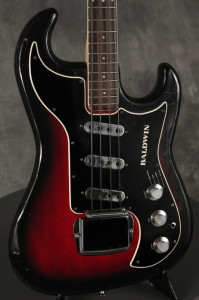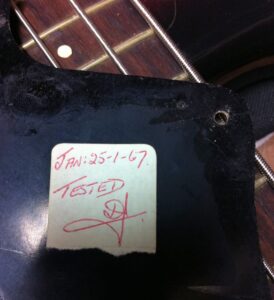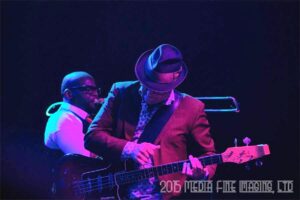1967 Baldwin Burns Jazz Bass
Due to a shortage of information on what’s become one of my favorite basses ever, I’m attempting to compile as much as I know about this instrument in a single place.
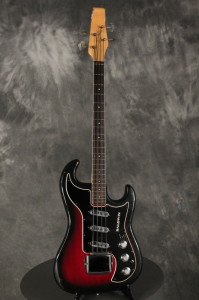 Mine is a 1967. Burns manufactured the Jazz Bass from ’64-’65 (http://www.brianmaycentral.net/burnshistory.html <- Google is saying this site now has malware on it…). Baldwin purchased the company in ’65 and the Jazz bass was continued until ’70 (http://www.guitar-list.com/baldwin/bass-guitars/baldwin-jazz-bass).
Mine is a 1967. Burns manufactured the Jazz Bass from ’64-’65 (http://www.brianmaycentral.net/burnshistory.html <- Google is saying this site now has malware on it…). Baldwin purchased the company in ’65 and the Jazz bass was continued until ’70 (http://www.guitar-list.com/baldwin/bass-guitars/baldwin-jazz-bass).
Specs:
- 22 frets
- 30.5″ scale
- Controls:
- Pickup selector – 4-position rotary switch
- Contrabass – Neck Pickup, with highs rolled off
- Bass – Neck and Middle Pickups
- Treble – Bridge Pickup
- Wild Dog – Middle and Bridge PIckups with Bridge out of Phase.
- I added the neck pickup to ‘Wild Dog’ to give it low end that was completely missing originally. The out-of-phase sound is still there, so it’s a nice contrast to the ‘Bass’ position.
- Tone
- Volume
- Pickup selector – 4-position rotary switch
- Burns patented Gear-o-Matik® Truss Rod Gearbox mechanism in heel of neck. geared low, i.e. requires more turns than traditional direct adjust truss rods. The modern gearing is 1:18. I don’t know if the old ones are the same. It turns easily and did take full turns where I’d normally have made only partial turns.
- Fully adjustable bridge with roller saddles on threaded shaft for side to side adjustment
- Burns Tri-Sonic pickups, but not split-sound that are mentioned frequently which only seem to be on the guitars. They are low impedance requiring transformers.
- Metal-button Van Ghent tuners with a streamlined cover. (http://www.retrofret.com/products.asp?ProductID=5545)
Truss rod tool and bolt head:


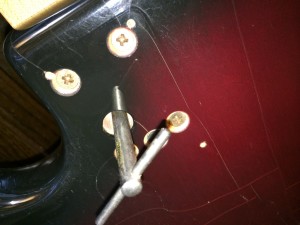
About the pickups (I contacted Burns UK and got the following response):
“Regarding the pickups – the low impedence units that you have were only made for a few years and then discontinued, never to return. Although the system worked quite well, it was massively expensive to produce/manufacture and really the same sort of sounds/tone could be achieved with the standard high impedence units which were fitted to different Burns models, at a fraction of the price. If you disconnect your pickups from the transformers, they will basically become useless and un-useable. If you try to wire high impedence units through the transformers it would probably work, but the residual noise would be ridiculous and there would be almost no high end frequencies whatsoever. All the new pickups currently supplied by Burns London are the high impedance standard units.”
He also said in another exchange:
“Regarding your E-mail to Burns London about the schematics/wiring on your Baldwin bass. There is a copy of the original UK Burns schematic printed in Paul Day’s “Green Burns Book”. However, this is a copy from an original heavily used schematic – and in all honesty is barely legible – and gives little info on component values etc.. Burns instruments were also notorious for changing spec on an almost weekly basis – this was really down to the availability of various components at that time. To make matters even more complicated, when Baldwin purchased Burns – much of the actual production moved to the large EKO plant in Italy. This also caused circuits/components to change. Regarding the “wild dog” setting – many people are under the impression that this was some sort of booster or overdrive sound. In fact, it was essentially an “out of phase” setting – which basically sucked the mid frequencies out of the signal. The pickups were normally very low impedance units and the small transformers under the pickguard boosted the coils back up. This was an attempt to achieve a very “clean” un-distorted type sound.”
Other feature of note – the awesome scroll headstock.
I use Thomastik-Infeld flatwound Jazz Bass strings – JF324
http://www.juststrings.com/toi-jf324.html – they’ve gotten expensive, but they really make the bass speak well. It’s amazingly consistent all over the neck with a nice fat sound around and above the 12th fret. It came with unidentified roundwound strings that were unremarkable.
I have a ’75 Gibson EB-3 that I also love, but it’s hard to play live because its sound is inconsistent on the lower frets, ranging from really dead to super boomy. I’ve had good luck recording it, but I don’t play it any more, though, because I moved the now 10-year old Thomastik strings to the Baldwin bass.
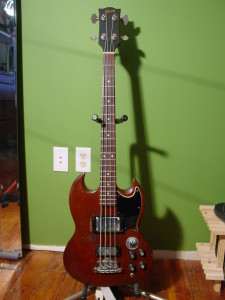
I would like to draw up a schematic with as much info as I can determine. The transformers are only labeled 3206 and 3136, which I’ve found is consistent with other Baldwin/Burns instruments, but I doubt I’ll ever figure out any more than that.
Sound Clips:
George Urgo Blues Band from our last summer in Philadelphia. I recorded this live at a Sunday brunch at Juniper Commons, April 2015.
Guitar, Vocals – George Urgo
Drums – Ben Diamond
Bass – Andrew Nelson
Other links:
- http://en.wikipedia.org/wiki/Burns_London
- http://www.burnsguitars.com (it appears that Baldwin dropped the guitar arm of the company and then it has since come back only loosely related as Burns Guitars.
